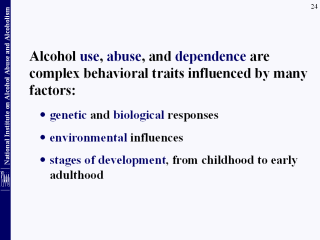Search for most updated materials ↑
| front |1 |2 |3 |4 |5 |6 |7 |8 |9 |10 |11 |12 |13 |14 |15 |16 |17 |18 |19 |20 |21 |22 |23 |24 |25 |26 |27 |28 |29 |30 |31 |32 |33 |34 |35 |36 |37 |38 |39 |40 |41 |42 |review |
 |
The initiation and continuation of
alcohol use by an individual is influenced by numerous factors,
chiefly the individual’s genetic makeup, the environments to which
he or she is exposed, and complex mechanisms through which genes
interact with one another and with the environment. These same
factors determine an individual’s pattern of alcohol consumption and
the risks for developing alcohol dependence (alcoholism) or other
alcohol use disorders.
Research has also revealed that
neither genetic nor environmental factors are static. That is, the
emergence and progression of drinking behavior and of drinking
consequences are influenced by multiple ongoing changes in biology,
physiological and psychological development, and environment that
occur over the course of a person’s life. These observations are in
accord with a broader recognition that human development continues
throughout life, rather than stopping after adulthood is reached.
The influence of alcohol on biology and behavior is dynamic and
changes as an individual moves from childhood into adolescence and
through the various stages of adulthood.
|